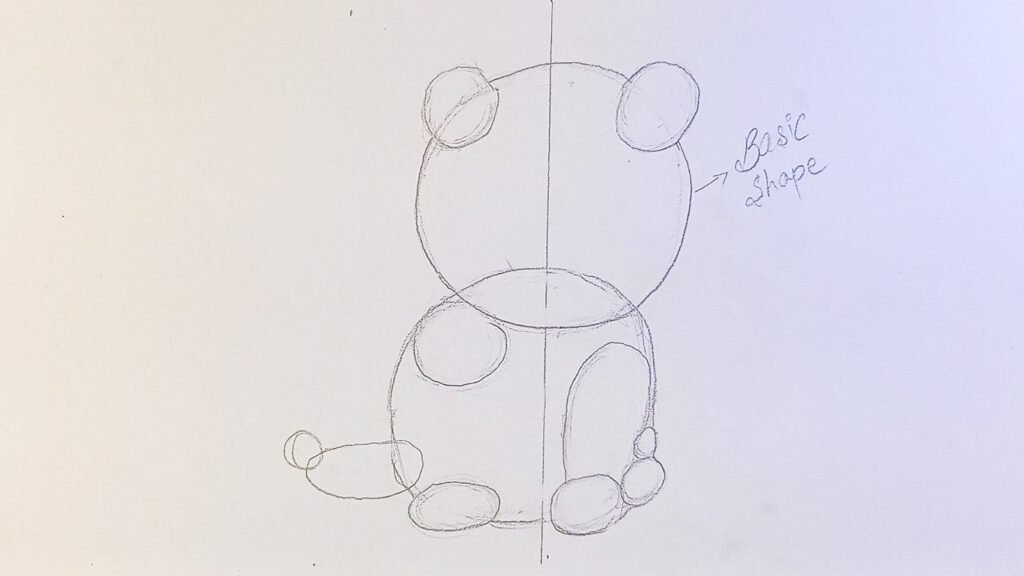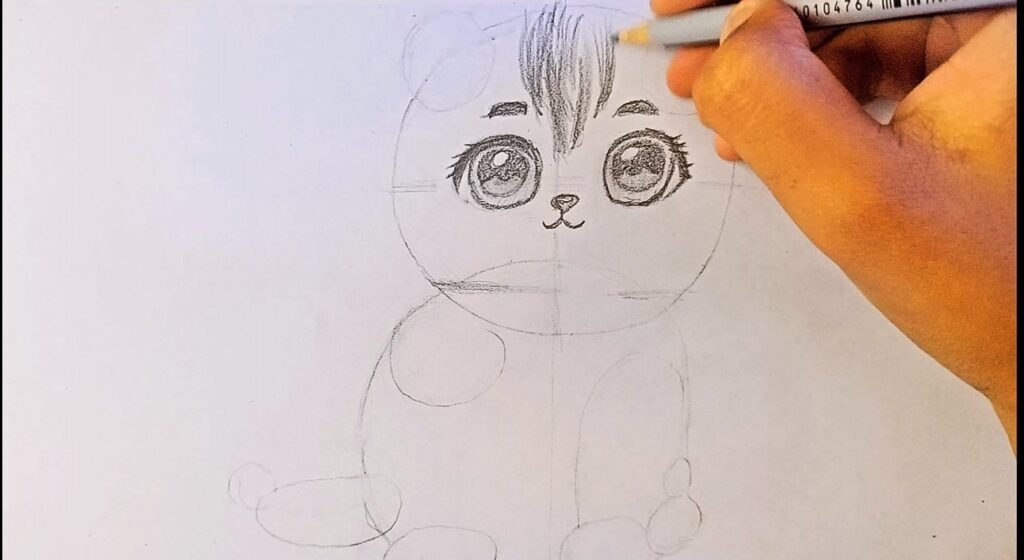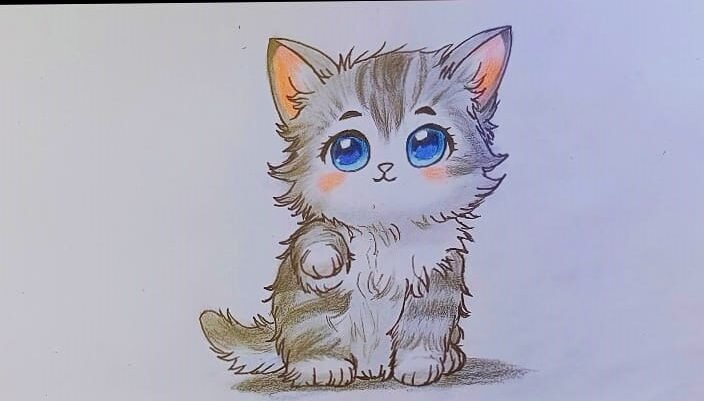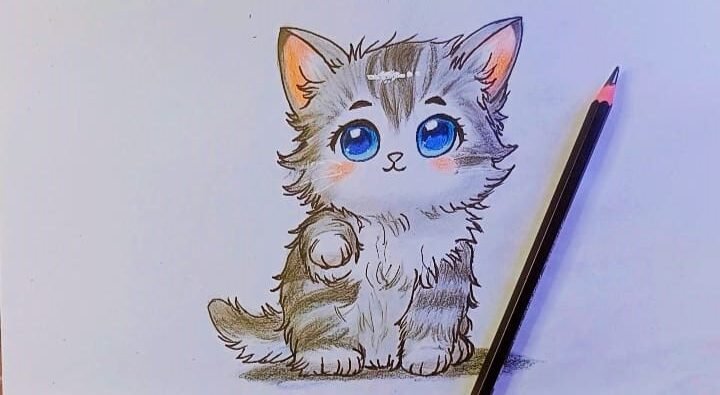Introduction to Easy Sketch of Kitten
Making an easy sketch of kitten is a brilliant prologue to drawing, reasonable for novices and prepared specialists alike. The fun-loving and beguiling highlights of cats offer a chance to rehearse essential portraying methods while catching the essence of a cherished pet.Start by framing the cat’s fundamental shape begin with a basic circle for the head and more modest circles for the body and paws. Center around extents, guaranteeing the head is somewhat bigger corresponding to the body, regular of cats. Detail the eyes, nose, and ears with delicate, light strokes to precisely lay out their positions. Use concealing sparingly to characterize the fur surface and create profundity, focusing on where shadows normally fall. This initial drawing exercise upgrades your imaginative abilities as well as permits you to communicate the kitten’s personality through basic yet viable strategies.
Material required
Making a simple sketch of a kitten requires fundamental materials that are effectively open and clear to utilize. Also read How to draw Easy Sketch of Lion.Here is a rundown of the fundamental materials you’ll require:
1. Drawing Paper
- Quality: Pick smooth, heavyweight paper (around 100–140 lb. or 160–250 gsm.) to forestall wrinkling and consider eradicating and mixing.
- Types: Sketch cushions or individual sheets, contingent upon your inclination and undertaking size.
2. Pencils
- Graphite Pencils: A bunch of graphite pencils (HB, 2B, 4B) for changing line loads and concealing. HB for light layouts and subtleties; gentler grades for hazier tones and concealing.
- Mechanical Pencils: discretionary for exact subtleties.
3. Eraser
- Manipulated Eraser: Pliable and delicate, ideal for lifting graphite without harming the paper.
- Vinyl Eraser: For more exact eradicating of little subtleties.
4. Mixing Devices
- Mixing Stumps/Tortillons: Moved paper sticks are used to mix graphite and make smooth advances.

- Tissue Paper: delicately rub for unpretentious mixing impacts.
5.Rawing Pens (DiscretionaryFine Liners):
- Waterproof pens in different thicknesses (0.1mm to 0.5mm) for framing and adding subtleties.
6.Gel Pens:
- discretionary for adding accents or features.
7.Photo:
- Pick an unmistakable, high-goal picture of a kitten for exact perception of elements, fur surface, and stance. On the other hand, use a toy or a genuine kitten as a live model.
8.Explore:
- Attempt various brands and kinds of pencils, paper, and erasers to find what turns out best for your style and procedure.
Step by step guidence
Making a sketch of a cat can be a wonderful venture for craftsmen of all levels of expertise. Here is a bit-by-bit manual to assist you with making an enchanting and similar portrayal of a kitten on paper:
Step 1: Accumulate Your Materials
Accumulate every one of the vital materials before you start:
- Drawing Paper: Pick smooth, heavyweight paper (around 100–140 lb. or 160–250 gsm.) to forestall wrinkling and take into account eradicating and mixing.
- Graphite Pencils: A bunch of graphite pencils (HB, 2B, 4B) for changing line loads and concealing.
- Eraser: a manipulated eraser for lifting graphite and a vinyl eraser for exact subtleties.
- Mixing Apparatuses: Mixing stumps or tortillons for smooth advances.
- Reference Picture: A reasonable, high-goal photo of a kitten for precise perception.
- Lighting: Work in a sufficiently bright region with regular light or utilize a steady fake light source.
- Planning phase: Gives a steady surface to drawing, particularly valuable for bigger craftsmanship.
Step 2: Set up Your Work Area
Set up your drawing materials on a spotless and sufficiently bright work area. Guarantee your paper is safely fixed to a planning phase or level surface to keep it from moving while you work.

Step 3: Layout Essential Shapes
Start by delicately portraying the essential shapes that will frame the cat’s head, body, and appendages:
- Head: Begin with a circle for the head, somewhat bigger than you mean the last size to be.
- Body: Draw an oval or extended shape underneath the head to frame the body.
- Appendages: Add more modest circles for the paws, situating them where the cat’s appendages will be.
- These underlying shapes act as an aid for the cat’s extents and generally speaking posture.

Step 4: Characterize Facial Elements:
Center around the position and size of the kitten’s facial highlights:
- Eyes: Sketch the eyes utilizing ovals or almond shapes, focusing on their position relative to one another and the head.
- Nose: Draw a little triangle or oval shape for the nose, focused between the eyes.
- Mouth: Add a straightforward, bended line for the mouth, somewhat underneath the nose.
- Keep your pencil strokes light and free at this step to take into account changes as you refine the subtleties.

Step 5: Add Ears and Tail
Sketch the kitten’s ears and tail to finish its fundamental diagram:
- Ears: Draw three-sided shapes on one or the other side of the head, situating them as per the kitten’s variety or posture.
- Tail: Broaden a bended line from the kitten’s body to address its tail, taking into account the tail’s length and position.
- These extra elements add character to your cat sketch.

Step 6: Refine with Light Overshadowing
Start adding light concealment to characterize the cat’s fur surface and make it deeper.
- Fur Bearing: Notice the reference picture to decide the heading of the kitten’s fur development. Utilize light, short strokes to impersonate the fur surface, beginning from the foundation of the fur and pursuing the tips.
- Concealing: Utilize a lighter graphite pencil (like HB or 2B) to conceal the lighter region of the cat’s fur, leaving a few regions immaculate for features.
- Zero in on slowly developing layers of concealing to accomplish a three-layered appearance while keeping up with the cat’s delicate and feathery surface.

Step 7: Itemizing Facial Highlights
Refine the kitten’s facial highlights with additional characterized lines and concealing:
- Eyes: Obscure the understudies and add features to create an enthusiastic articulation. Utilize a hazier pencil (like 4B) for the eyelashes and eyebrows, upgrading the kitten’s eyes.
- Nose: Shade the sides of the nose somewhat to give it an aspect. Add a little feature on the tip of the nose for a sensible impact.
- Mouth: Characterize the state of the mouth with delicate bends and concealment to show lips and mouth structure.
- Give close consideration to the reference picture to precisely catch the particular subtleties of the kitten’s face.

Step 8: Refine the Appendages and Body
Detail the cat’s appendages and body, zeroing in on muscle definition and fur surface:
- Paws: Add little lines to recommend paw cushions and fur tufts around the edges of the paws. Use concealment to demonstrate the arch and volume of every appendage.
- Body: Upgrade the fur surface by fluctuating your pencil tension and bearing of strokes. Obscure concealed regions to make difference and profundity, particularly where the body bends or curves.

Step 9: Last Contacts and Features
Complete your kitten sketch by adding the following contacts and features:
- Features: Utilize a manipulated eraser to tenderly lift graphite and make features on the kitten’s fur, especially on regions presented to light.
- Subtleties: Add any leftover subtleties like hairs, little fur tufts, or examples on the fur to upgrade authenticity and character.
- Foundation (discretionary): Consider adding a straightforward foundation or leaving the drawing zeroed in exclusively on the an easy sketch of kitten, contingent upon your creative vision.

Step 10: Assess and Change:
Step back and assess your cat sketch in good ways in your an easy sketch of kitten. Make any essential changes in accordance with extents, concealments, or subtleties to accomplish your ideal outcome. Utilize your eraser, depending on the situation, to refine edges or ease up regions for a cleaner finish.
Step 11: Sign and Date
Sign your an easy sketch of kitten in a corner with a fine pencil or pen, along with the date, to check its fruition.

Step 12: Partake in Your Work of Art
Respect and value your completed kitten sketch. Show it gladly or share it with others to show your imaginative accomplishment and commitment to catching the excellence of nature on paper.
Drawing a kitten gives a charming person an open door to rehearse essential drawing strategies while communicating your inventiveness and reverence for these cherished creatures. With each sketch, you’ll acquire trust in your abilities and foster your one-of-a kind creative style.
Tips for an amazing cat sketch
Making the ideal kitten sketch includes a mix of perception, method, and tolerance. Here are a few fundamental tips to assist you with catching the appeal and character of a kitten in your craftsmanship:
1. Concentrate on Your Reference Picture
Before you begin drawing, get some margin to concentrate on a reasonable, high-goal photo or notice a live kitten. Focus on subtleties like the state of the eyes, the surface of the fur, and the positioning of the ears and tail. Understanding these subtleties will assist you with repeating the kitten’s resemblance all the more precisely.
2. Begin with light portions.
Utilize a light touch with your pencil to frame the essential states of the kitten. Start with straightforward structures like circles for the head and body and ovals for the paws. This approach permits you to make changes effectively without leaving weighty lines on the paper.
3. Center around Extents
Kittens have particular extents, with huge heads and eyes compared to their bodies. Guarantee the eyes are set accurately, normally one eye’s width separated, and the nose is situated underneath the eyes, focused between them. Remembering these extents will give your sketch a practical and adjusted look.
4. Catch the Articulation
Kittens are known for their expressive appearances. Underline the eyes, which are the point of convergence of the face. Utilize hazier pencils for the students and add little features to make them seem exuberant. Focus on the shape and size of the ears and the slight bend of the mouth to convey the kitten’s state of mind.
5. Add Surface with Short Strokes
To portray the delicateness and cushiness of the cat’s fur, utilize short, directional strokes. Shift the tension on your pencil to make various shades and surfaces. For areas of fur, go through a light hand and fabricate layers continuously to achieve a practical fur surface.
6. Mix and Shade for Profundity
Use mixing devices like tortillons or delicate tissue to streamline concealing and make changes among light and dim regions. This strategy adds profundity and volume to your sketch, causing the fur to show up more three-layered. Center around the areas where shadows normally fall, like under the jaw and around the eyes.
7. Consolidate Fine Subtleties:
Add fine subtleties like hairs, minuscule fur tufts, and inconspicuous examples. Utilize a sharp pencil or a fine liner for these subtleties; they are fragile and exact to guarantee. These little contacts can fundamentally upgrade the authenticity and appeal of your cat sketch.
8. Step back and refine
Routinely move away from your work to survey the general arrangement and equilibrium. This distance assists you with detecting any irregularities or regions that need refinement. Utilize an eraser to ease up regions or change lines, and improve features to rejuvenate the cat’s highlights.
9. Practice tolerance and diligence.
Drawing a cat, similar to any subject, requires practice and persistence. Try not to rush the cycle. Take as much time as necessary to notice, sketch, and refine your work. Each endeavor will work on your abilities and bring you closer to making the ideal cat sketch.
10. Partake simultaneously.
At long last, partake in the excursion of outlining. Embrace the most common way of catching the lively soul and charming highlights of a cat. Your excitement and love for the subject will radiate through your fine art, making it really extraordinary to draw easy sketch of kitten.
Frequently Asked Questions:FAQs
1. What materials do I have to draw a kitten?
To draw a cat, you’ll require drawing paper, graphite pencils (different grades), erasers (manipulated and vinyl), mixing devices (like tortillons), a reference picture of a cat, and a sufficiently bright work area.
2. How would I begin drawing a cat on the off chance that I’m a fledgling?
Start by drawing essential shapes to frame the cat’s head, body, and appendages. Utilize light pencil strokes to lay out extents and slowly add subtleties like eyes, noses, and ears.
3. How might I catch the fleecy surface of a kitten’s fur?
To portray a fur surface, utilize short, directional pencil strokes. Differ your strain to make light and dim regions, and mix delicately with a tortillon for a reasonable impact.
4. What would it be a good idea for me to zero in on to make my cat drawing sensible?
Center around extents, light and shadow, and subtleties like stubbles and paw cushions. Notice your reference picture near imitating the cat’s highlights precisely.
5. Would it be a good idea for me to utilize references while drawing a kitten?
Indeed, utilizing an unmistakable reference photograph or noticing a live kitten is vital for exactness in catching subtleties and extents. It assists you with grasping the life systems and remarkable qualities of cats.
6. How might I add profundity to my kitten drawing?
Add profundity by concealing regions where shadows normally fall, like under the jawline and around the eyes. Use mixing apparatuses to smooth changes among light and dull regions.
7. What normal mix-ups would it be a good idea for me to stay away from while drawing a cat?
Abstain from workaholic behavior on the paper, ignoring extents, utilizing unforgiving lines, hurrying the cycle, and not utilizing a reference. These slip-ups can influence the authenticity and nature of your kitten drawing.
8. How might I further develop my kitten’s drawing abilities?
Practice routinely and explore different avenues regarding various methods. Concentrate on life structures and notice genuine cats to improve your comprehension and capacity to catch their extraordinary attributes.
Conclusion
All in all, to make an easy sketch of kitten is a compensating imaginative undertaking that permits you to catch the energetic honesty and appeal of these darling creatures. By following the means and tips illustrated, you can make a sketch that exhibits the remarkable elements and character of a cat.Make sure to begin with fundamental shapes and extents, utilize light strokes to frame and characterize subtleties step by step, and focus on light and shadow for profundity and authenticity. Keep away from normal entanglements like workaholic behavior, dismissing extents, and surging the cycle.

